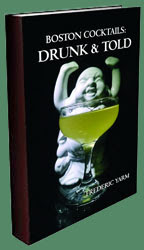On Tuesday, I attended the first installment of the Diageo World Class classes that are the educational series leading up to the competition. While I have no plans of competing in this event right now, I am always game for gleaning knowledge from experts. The first session of the day's three was led by Charles Joly who won World Class in 2014, and the title was "Ketel One Food Pairing."
Charles began by describing how he initially solely relied on his chef and trusted his palate and the way he could break things down. And even today, when he takes on a consultancy, the first thing he does is walking into the kitchen to see what the chef is playing with. Traditionally, most pairings have been food and wine, and people declared that cocktails were both too high in ABV and too flavorful. However, while sommeliers have fixed constraints by what the vintners put in a bottle, bartenders can endlessly alter recipes to better fit the food.

Charles next discussed the history of vodka and food pairings, and in doing so, made a good argument for its place on the menu. Vodka tasting can actually be rather challenging because the subtleties of flavor require a fresh palate as opposed to analyzing a set of Scotches; Charles described a lineup of vodkas to taste as "the thinking flight." Vodka has traditionally been paired with food for quite a long time especially in Eastern Europe and Russia. In many of these countries, there will always be at least hors d'oeuvres while drinking. Moreover, flavored vodkas go back hundreds of years -- perhaps from the beginning -- whether to hide off flavors in the distillate or to enhance the spirit with seasonal ingredients.
Charles then addressed the difference between taste and flavor. Taste is the standard five of sweet, sour, bitter, salt, and umami, while flavor is everything else including aroma and texture. Many of the the five tastes work to enhance or balance the others. With salt and umami, they balance bitterness and enhance sweetness; this is why a peanut butter and jelly sandwich works so well. With sweet, it balances sour, bitterness, and spice, and it enhances salt which is why salted caramel is so delicious. With sour, it works with spice and sweetness and enhances salt. Charles continued to describe how many bartenders add a pinch of salt (or dash of saline) in a Sour recipe and why the salted rim in a Margarita is so successful in brightening the flavors; note, this is not a perceivable amount of salt -- if you can taste the salt, it is too much. Finally, bitterness balances sweet and salt. Bitterness is what makes grapefruit a very different citrus fruit; for example, its addition in a Hemingway Daiquiri along with Maraschino is very different than just a Daiquiri with Maraschino.

In pairings, one possibility is to complement with a like mirroring a like whether in structure, flavor, texture, intensity, or bridging ingredients. The other possibility is to contrast where opposites attract whether in structure, flavor, or texture. With the drink, you do not want to beat up the chef's food; the goal is to complement but not overwhelm or muddy things up either. So keep it simple. Often the bartender does not have the opportunity to try out the foods and only has the menu description in hand. Moreover, the drink might be pairing with multiple dishes served during the same course or spanning two courses.
In terms of alcohol percentages, low alcohol is important since it helps with food; however, high ABV can cut through fat. A downside of boozy drinks is that it can enhance spice and make things too hot as well as get the guests too trashed to appreciate the later courses that the chef prepared. Indeed, smaller servings is a way to overcome these alcohol quantity concerns. When designing drinks, calculating the ABV is rather helpful. Consider a 30% dilution as a good standard; see the image below for an example of this calculation. In looking for inspiration, do not think of mirroring the exact ingredients that are in the dish; instead, look regionally and culturally to add elements found in that food's culture. Finally, subtlety is key in food pairings such as using only a light touch instead of a heavy hand with absinthe.

Charles offered a few examples along the way of food pairings and their effects before we got to tinker at the bar setups in the back of the room to create pairings with two dishes. During the vodka tasting section, pickled fish with all of its salt, vinegar, and umami worked excellent with Ketel One. Charles noted that the pickleback was nothing new for the Scandinavians had long utilized this phenomenon as the brine balances out the acid in the booze. Next, Ketel One Oranje when matched with Camembert accented the cheese's earthy, sweet, umami, and creamy notes. When presented with a steak with peppercorn sauce and dill, many will think about a Manhattan which is a more drastic pairing. A softer pairing can be achieved with a drink including lemon juice, a fruity Lambic beer, and some herbs; here, acid instead of tannin is utilized to cut the fat, and the Lambic beer is hinting towards a shrub. Finally, with a New York-style cheesecake topped with blueberry sauce, a Campari drink (vodka, Campari, and a barspoon Fernet) brought out the cheesiness, salt, umami from the cake and enhanced the fruit in the sauce. Charles would be hesitant to serve a Campari drink like this to a wider audience, but with a room of bartenders, he felt comfortable. Also, a drink such as this needs to be served well chilled, so a smaller portion besides cutting back on the alcohol consumption will help ensure that it does not get too warm and thus flabby or unbalanced.



 The 2017 collection of 855 drink recipes, bartender tributes, and essays on hospitality from CocktailVirgin's Frederic Yarm. Available at
The 2017 collection of 855 drink recipes, bartender tributes, and essays on hospitality from CocktailVirgin's Frederic Yarm. Available at  The 2012 collection of 505 drink recipes, techniques, and Boston bar recommendations from Frederic Yarm. Available at
The 2012 collection of 505 drink recipes, techniques, and Boston bar recommendations from Frederic Yarm. Available at 




No comments:
Post a Comment